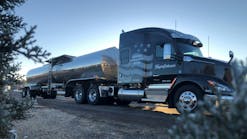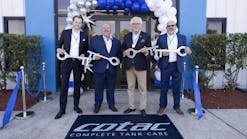Quala’s environmental director talks policies, procedures and documentation for heating product in tank trailers
WHEN it comes to steaming product, Quala always keeps it (at least) 100.
And to help prevent customers from becoming steaming mad trying to understand its methodologies, Quala sent environmental director Chuck Boyd to NTTC’s 2019 Safety & Security Council Meeting to talk about training, documentation and more associated with heating product with steam.
“I’m not an expert on steaming, but I am the final approving authority for steaming at Quala,” Boyd said.
Process training
First, it’s important to understand Occupational Safety and Health Administration (OSHA) standard 1910.119, aka process safety management of highly hazardous chemicals, which contains the requirements for preventing or minimizing the consequences of catastrophic releases of toxic, reactive, flammable or explosive chemicals.
The standard covers many key aspects of process management for hazardous materials, including handling, and the rules for heating flammable gasses and liquids with flashpoints less than 100 degrees Fahrenheit. Because Quala doesn’t have a process in place to meet this OSHA requirement, the industrial services company doesn’t heat any loaded product with a flashpoint below 100.
For products Quala will steam, the process starts with its chemists, based in the company’s Tampa, Florida headquarters, obtaining and reviewing all information pertaining to safe heating for customers.
For example, if the customer is hauling product with Zinc, Quala will reference the product manufacturer’s applicable guidance documents to determine how, and how high, to safely heat the product.
“You need to make sure the people looking at the documents understand what they’re looking at and can process the information,” Boyd cautioned. “We look a lot at the SPS (safety data sheet), as well as the bill of lading, and the manufacturer’s information.”
The employees who do the steaming need to understand the policies and procedures for steaming as well as the chemists, including how high to heat the product, how much pressure to apply, and how to verify that associated gauges are working properly, which Boyd said can be tricky.
“We don’t have a magic wand to tell if it’s heating, so we have guidelines in place that (say), after so much time, you need to check that temperature gauge, and if it’s not rising, stop, call someone and try to figure out what the problem is,” Boyd said.
Quala also has rules for heating compartment trailers.
If a customer wants product in one compartment heated but the adjacent compartment is dirty, Quala won’t heat the product because whatever is in the second compartment could be flammable, or inadvertently baked onto the tank container. So Quala, by company policy, first must clean the adjacent compartment at one of its facilities to ensure positive control of the container.
And when heating product in compartment trailers, Quala procedures also call for technicians to add water to any adjacent empty compartments, which helps prevent trailer buckling or overheating.
Finally, different types of heating include high- and low-pressure steam, and hot-water cleaning. Because certain products can’t be heated higher than 200 degrees F, and steam is produced only at temperatures higher than 200 degrees, these products only can be heated with water.
Quala requires, and recommends other steam-heating companies obtain, several key documents, including bill of lading, SPS, requested temperature range and manufacturer’s chemical-specific data.
The requested temperature range document includes the manufacturer’s suggested temperatures and the temperature to which the customer wants the product heated, which must be recorded.
“We realize (the manufacturer) may say, ‘Heat to 145,’ and the customer will come in and say, ‘Can you heat it up to 160?’ because they want to make sure (the product) is delivered at 145,” Boyd said. “So we don’t just look at the bill of lading and say, ‘Nope it’s 145.’ We understand there are limits to that.”
The SDS may contain heating restrictions, but that information more commonly is found in the manufacturer’s chemical-specific literature, Boyd said.
“Periodically, we get a bill of lading and an SDS that do not match,” Boyd said. “It may be off a few numbers but be the same type of product, or it could be completely different. There are many reasons for that but we make sure that we request the bill of lading and the SDS, and the most important thing we need from the customer, in order to heat a product, is what temperature do you want.”
Product data sheets, or technical data sheets, often are available online. They outline restrictions and common scenarios, and provide critical details informing boiling points and heating limits.
Boyd said Quala, in most cases, will follow the manufacturer’s recommendations, even if they could heat the product higher. But if a customer wants a product heated higher than the manufacturer recommends, and Quala agrees, the request must be made in writing and signed by the customer.
“We’ll have you sign the Hold Harmless, and we’ll go ahead and heat it to the temperature you want, if we think it’s safe,” Boyd said.
Any other special instructions, like draining antifreeze or water in the steam coils before steaming, or breaking seals, also must appear in writing.
Some manufacturers list pressure and/or temperature limits that shouldn’t be exceeded. For instance, oil additives with ZDDP (Zinc dialkyldithiophosphates) cannot be heated to more than 15 pounds per square inch (psi).
Other products, like isocyanates, stipulate hot-watering heating only.
Boyd said Quala doesn’t like heating those types of products, but the process can be completed safely up to certain temperatures.
Then there are products like molten sulfur, which only melts at high temperature—approximately 320 degrees Fahrenheit—and pressure. Boyd said many of Quala’s boilers only pressurize up to 50 psi, which isn’t enough to melt sulfur, so only facilities with 90-psi boilers can handle the request.
Quala’s conversions for saturated steam-pressure to temperature are:
• 5 psig (pounds per square inch gauge) = 227 °F
• 50 psig = 297 °F
• 90 psig = 331 °F
“If it says in there do not heat with any temperature above 220 degrees F, the lowest we can go on any steam is 5, and really we can’t go down to 5 because the gauges aren’t that accurate, so we would have to heat that with hot water,” Boyd said. “And we typically don’t take a Hold Harmless agreement to go ahead and do it with steam because the SDS says not to heat with a temperature greater than 220.”









